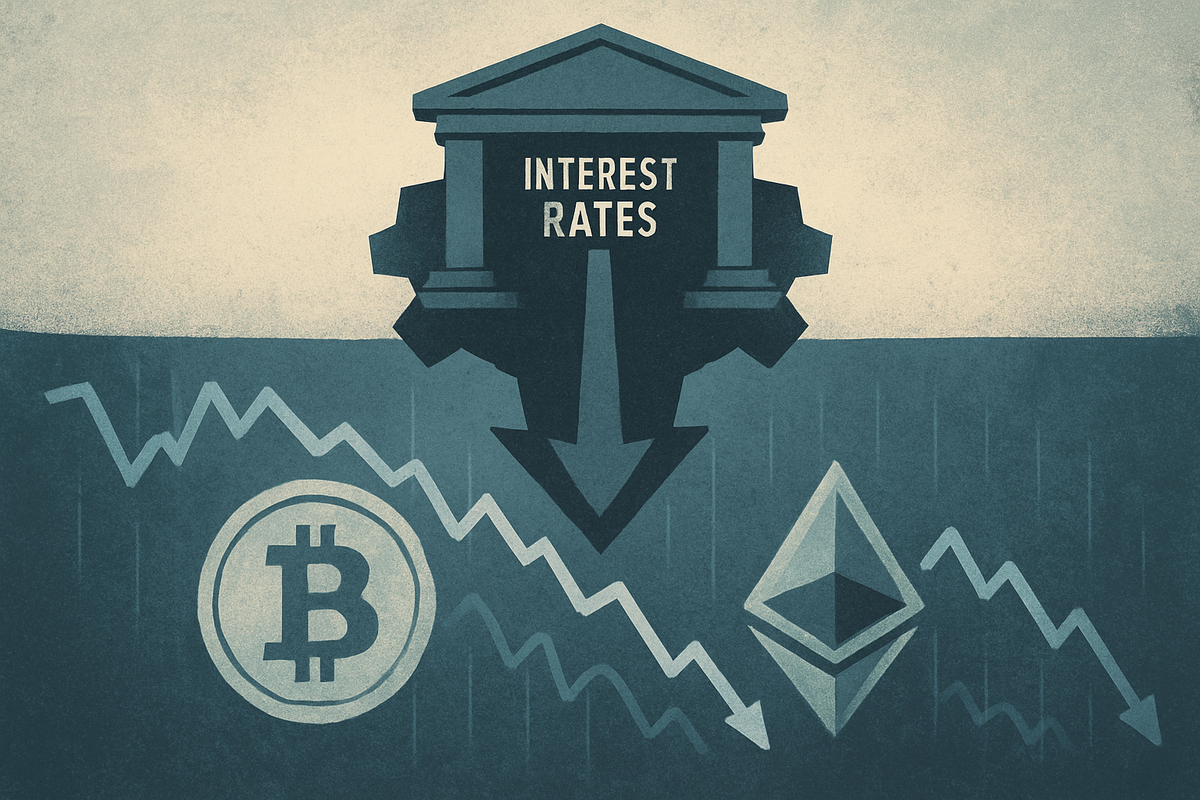
October 21, 2025 — The cryptocurrency market, particularly bellwethers Bitcoin (BTC) and Ethereum (ETH), typically faces immediate headwinds when the U.S. Federal Reserve implements interest rate hikes. These policy shifts, aimed at curbing inflation and stabilizing the economy, directly influence investor behavior and market liquidity, pushing capital away from speculative assets like digital currencies.
Rising US interest rates cast an immediate shadow over the cryptocurrency market. As the cost of borrowing increases and safer investments offer more attractive returns, capital tends to flow out of high-risk, speculative assets like digital currencies. This shift in investor sentiment and market dynamics leads to a reduction in overall market liquidity for cryptocurrencies.
The Federal Reserve's Grip on Digital Assets
The Federal Reserve's decisions on interest rates are a critical determinant of financial market conditions, and their ripple effect extends significantly to the cryptocurrency market. When the Fed raises rates, it makes borrowing more expensive across the financial system. This directly impacts the availability of "cheap capital" that often finds its way into speculative investments like cryptocurrencies. Consequently, market liquidity diminishes, making it harder for investors to enter and exit positions without significant price movements.
A key mechanism through which rate hikes impact crypto is the increased attractiveness of traditional, lower-risk assets. As interest rates climb, government bonds, money market accounts, and even high-yield savings accounts begin to offer more compelling returns. This raises the "opportunity cost" of holding non-yielding assets such as Bitcoin (BTC) and Ethereum (ETH). Investors, seeking to maximize returns while minimizing risk, often reallocate capital from volatile cryptocurrencies to these safer, interest-bearing alternatives, thereby decreasing demand and exerting downward pressure on digital asset prices.
Furthermore, rising interest rates typically lead to a strengthening U.S. dollar. Given that most major cryptocurrencies are priced against the USD, a stronger dollar makes these digital assets relatively more expensive for international investors. Historically, Bitcoin has shown an inverse correlation with the dollar, meaning a robust dollar often coincides with a decline in Bitcoin's value. This dynamic further compounds the negative impact of rate hikes on crypto valuations.
The overall market sentiment also plays a crucial role. Cryptocurrencies are widely perceived as high-risk, speculative investments. In an environment of tightening monetary policy and rising rates, investors generally become more risk-averse. This shift in sentiment leads to a broad decline in the appetite for speculative assets, directly affecting the demand and pricing of Bitcoin, Ethereum, and the broader altcoin market as investors prioritize stability and capital preservation over potential high returns.
Winners and Losers in a Rising Rate Environment
In a rising interest rate environment, the cryptocurrency market experiences a clear delineation of potential winners and losers. The most apparent "losers" are often the major cryptocurrencies themselves, especially those that are primarily held for speculative purposes and do not offer inherent yield or significant utility beyond store-of-value or transactional capabilities. Bitcoin (BTC) and Ethereum (ETH), despite their foundational roles, can see significant price depreciation as investors pivot to less risky assets. Companies heavily invested in mining operations, such as Marathon Digital Holdings (NASDAQ: MARA) and Riot Platforms (NASDAQ: RIOT), may also face increased operational costs due to higher borrowing rates for equipment and energy, potentially squeezing their profit margins.
Conversely, some entities within the broader financial ecosystem might "win" or at least be more resilient. Traditional financial institutions that offer yield-bearing products, such as banks and bond funds, become more attractive to investors. While not directly crypto-related, the capital flowing into these sectors often comes from assets like cryptocurrencies. Within the crypto space itself, projects focusing on real-world utility, stablecoins, and decentralized finance (DeFi) platforms offering competitive yields might experience relative stability or even growth. Stablecoin issuers like Tether (USDT) and Circle (USDC) could see increased demand as investors seek a safe haven within the crypto market, providing liquidity and stability during volatile periods. DeFi lending protocols that can dynamically adjust their interest rates to remain competitive with traditional finance might also fare better.
Companies with strong balance sheets and minimal reliance on debt, or those that have diversified their revenue streams beyond pure crypto speculation, are also better positioned to weather the storm. For instance, companies that provide essential infrastructure services to the crypto market, such as blockchain analytics firms or secure custody solutions, might see continued demand regardless of market sentiment, albeit potentially at a slower growth rate. However, any company with significant exposure to highly leveraged positions or those reliant on continuous capital injections for growth will likely struggle in an environment of higher borrowing costs and reduced liquidity.
Wider Significance and Historical Context
The Federal Reserve's influence on the cryptocurrency market is a significant aspect of broader industry trends, particularly the increasing interconnectedness between traditional finance (TradFi) and the nascent digital asset space. This event underscores the fact that cryptocurrencies, once touted as a completely uncorrelated asset class, are increasingly susceptible to macroeconomic forces and monetary policy decisions. This integration means that crypto market movements are no longer solely driven by internal technological developments or adoption rates, but also by global economic indicators, inflation data, and, crucially, central bank actions.
The ripple effects extend beyond direct price impacts, influencing competitors and partners across the financial landscape. For instance, traditional financial institutions that have ventured into offering crypto services, such as major banks or asset managers, may face reduced client demand for these products during periods of rising rates, potentially slowing their digital asset initiatives. Conversely, the increased stability offered by TradFi investments could draw capital away from crypto, forcing digital asset firms to innovate and offer more compelling value propositions. Regulatory bodies are also closely observing these dynamics, and sustained volatility linked to macroeconomic factors could embolden calls for stricter oversight and consumer protection within the crypto sector.
Historically, there have been clear precedents for how tightening monetary policy affects speculative assets. During periods of aggressive rate hikes, such as the early 1980s or more recently in 2022, asset classes perceived as risky, including high-growth technology stocks and commodities, have often experienced significant downturns. The cryptocurrency market, with its inherent volatility and speculative nature, tends to exhibit similar sensitivities. The 2022 rate hike cycle, for example, saw significant corrections across Bitcoin and Ethereum, demonstrating a clear inverse relationship between rising rates and crypto valuations. These historical comparisons highlight that while the asset class is new, its response to fundamental economic shifts often mirrors that of other speculative investments.
What Comes Next: Navigating the Shifting Tides
Looking ahead, the cryptocurrency market faces a period of continued adaptation to the evolving interest rate landscape. In the short term, further rate hikes or even the sustained expectation of higher rates will likely maintain downward pressure on Bitcoin, Ethereum, and the broader altcoin market. Investors should anticipate continued volatility and potential price corrections as capital reallocates to less risky assets. Market opportunities may emerge for those with a long-term perspective, as dips could present accumulation opportunities for fundamentally strong projects. However, the immediate future suggests a challenging environment for speculative growth.
In the long term, the market's response will depend on several factors, including the duration and magnitude of the Federal Reserve's tightening cycle, the global economic outlook, and the continued maturation of the crypto industry itself. A prolonged period of high interest rates could force strategic pivots among crypto projects, emphasizing sustainable business models, real-world utility, and robust tokenomics over pure speculative appeal. Projects that can demonstrate consistent value creation and resilience in a tighter capital environment are more likely to thrive.
Potential strategic adaptations include a greater focus on institutional adoption, as large institutional players might be less swayed by short-term rate fluctuations and more interested in long-term technological innovation. Furthermore, the development of sophisticated DeFi products that can offer competitive, inflation-beating yields could become increasingly important, providing an alternative to traditional financial instruments. Market challenges will undoubtedly include reduced liquidity, increased investor scrutiny, and potentially slower growth in user adoption as the barrier to entry for speculative investing rises.
Potential scenarios range from a "soft landing" where the Fed successfully tames inflation without triggering a deep recession, allowing crypto to eventually regain momentum, to a more severe downturn if aggressive rate hikes lead to a significant economic contraction. In the latter scenario, cryptocurrencies, as high-beta assets, could experience more pronounced declines. Investors should closely monitor inflation data, Fed communications, and global economic indicators, as these will be crucial in shaping the trajectory of the cryptocurrency market in the coming months and years.
Navigating the New Financial Paradigm
The Federal Reserve's tightening monetary policy and its subsequent ripple effect on the cryptocurrency market underscore a pivotal shift in the financial paradigm. The days of crypto operating in a silo, detached from traditional economic forces, appear to be largely over. The key takeaway from this event is the undeniable interconnectedness of digital assets with global macroeconomic trends, particularly interest rate decisions. Investors must now acknowledge that the cost of capital and the availability of liquidity in traditional finance directly influence the valuations and sentiment within the crypto sphere.
Moving forward, the market will likely be characterized by increased maturity and a greater emphasis on fundamental value. Projects with clear utility, strong development teams, and sustainable economic models are better positioned to weather periods of monetary tightening. The era of "easy money" that fueled much of crypto's explosive growth is giving way to an environment where prudent financial management and demonstrable value are paramount. This assessment suggests a more discerning market, where speculative bubbles may be less frequent and more quickly corrected.
The lasting impact of rising interest rates will likely be a more resilient and perhaps less volatile cryptocurrency market in the long run, as it sheds some of its purely speculative elements and integrates more deeply into the broader financial system. Investors should watch for several key indicators in the coming months: the Federal Reserve's future rate decisions and forward guidance, inflation reports, global economic growth data, and, within the crypto space, the continued development of regulatory frameworks and institutional adoption. These factors will collectively shape the trajectory of Bitcoin, Ethereum, and the wider digital asset ecosystem as they navigate this new financial landscape.
This content is intended for informational purposes only and is not financial advice





